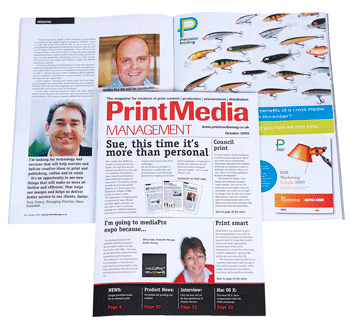One of the great benefits of managing an award competition like the Best-of-the-Best Program is seeing the great variety of work that is constantly being created by our customers. All submissions are unique in their own right; varying in target audience, intent, output, and effectiveness. I’ve always found great intrigue in reading the story behind each submission to learn more about who the piece was intended for, why the piece was actually created, and what goals it had set out to accomplish. Perhaps no story was stronger in this year’s Best-of-the-Best Contest than a winner in the Books and Manuals Category, MBA Group Ltd., of the United Kingdom, who aimed to help major publication Print Media Management (PMM) recover from a difficult economic climate in which print advertising budgets were slashed, leading to magazines suffering dramatic declines in revenue.

In order to increase revenue, MBA Group’s primary objective was to protect and enhance advertising revenue. Building greater loyalty between the readers and the advertisers was essential in order to accomplish this. With their recently acquired Xerox 980 Color Continuous Feed Printer, which can print up to 226 feet per minute, and clever usage of XMPie, MBA Group set out to produce the world’s first 100% variable magazine. This would undoubtedly resonate with readers as it would provide them with articles tailored to their interests, but would also provide extremely valuable opportunities to advertisers. PMM would also largely benefit, as they would be able to generate more revenue per page. In the past, PMM would sell a single page to a specific advertiser, but with the addition of variability they could now segment a page and sell it to several advertisers at a lesser cost, but while still attaining greater combined revenue.
Reading about the challenges that PMM faced and how MBA Group constructed a strategy to meet their client’s objectives was incredible, but seeing the fully variable magazine was even more awe-inspiring. To create variability, MBA Group first segmented the reader base into four primary audiences and developed content for each, including custom editorials and targeted advertising. With so much customization, managing the PDF workflow would seemingly be difficult. With the help of Xerox FreeFlow Process Manager, MBA Group was able to streamline the PDF’s for a touchless workflow, allowing all 12,400 readers to each receive their own unique edition of the Print Media Management publication.
With targeted advertising and the ability to reach an engaged reader, PMM was able to generate a 24% increase in advertising revenue. Additionally, PMM found that the personalized approach helped increase the amount of leads for advertisements by an incredible 256%. The success of the fully customized Print Media Management publication has opened many new and exciting possibilities for MBA Group, further validating their purchase of the Xerox 980 Color Continuous Feed Printer. Within the first year of ownership, it has already generated £1 Million in revenue! This yet again showcases what I admire most about the Best-of-the-Best Contest: real customers achieving remarkable results in the face of some of the industry’s most difficult challenges, and receiving the recognition they rightfully deserve.
To learn more about this campaign from MBA Group Ltd., please read the case study.
20 Comments
Comments are closed.



Hi Bill –
This is not exactly the first. Time magazine did a 100% web-to-print magazine about a year ago. I was on of the 30,000 to get the printed version. It was very cool and the Lexus ads were variable based on the “Interests” I indicated on the web form.
It’s no longer available since it was a test. However, here’s an article on it.
http://www.slate.com/id/2219063
Enjoy!
Hello Stephanie,
Thank you so much for your interest in my post, and for contributing to this blog!
The linked article you provided was very interesting, and is further proof to the power of personalization, and the growing desire we have for instant gratification. The Internet is such a powerful and favorable resource for reading and collecting information, however as the author mentioned, print still holds a very valuable role with many of its consumers. And by combining the relevant, personalized content that we all crave, with the comfortable and traditional medium of print – you now have a very valuable and effective resource.
I didn’t realize that Time Magazine had explored this exciting concept last year, but am very glad to hear that both you and the author of your linked article had favorable opinions of the personalized magazine. Personalization not only provides value to the reader, but also benefits advertisers by marketing their products and services to a more finite and specific audience. In return, the publication benefits from rejuvenated readers and advertisers. It’s a very interesting concept, and I think we will begin to see more publications use this strategy of providing personalized content in the future.
Thank you again for providing your feedback!
– Bill
Hi everyone
Stephanie is right to highlight Time Magazine, but as the article she refers to states “the project is bankrolled by Toyota, whose Lexus ads plaster the back and inside covers of Mine”. This is less of a magazine and seems more of a promotional item for Lexus.
The Print Media Management (PMM) magazine was not sponsored by MBA. It contained various news articles (many about our competitors) and numerous advertisers (not just MBA).
Four things make this publication different. First, it’s fully digital. Not a digital/litho combination. This opened opportunities for personalisation and variable content on every page.
Second, it uses offline data – not data that has been built or amended via a web page. This means every reader gets variable content and personalisation, not just those that completed an online form.
Thirdly, it has both variable editorial and advertising throughout the publication. This ensures the content is relevant to the reader; more relevance means greater readership and response.
Finally, it’s environmentally friendly – using toner based technology rather than inkjet (inkjet produces problems in the paper recycling process, see http://www.printweek.com/environment/news/1011703/MBA-lobbies-Euro-chiefs-inkjet-ink-paper-recycling ).
Now publishers have the opportunity to deliver relevant editorial content for every reader, helping to build greater loyalty to their publication.
Advertisers can select which readers they wish to reach (reducing wastage and increasing return on investment), and publishers have the opportunity to sell the same page to several advertisers (increasing page yield).
We understand a weekly newspaper in Europe is planning to produce a regular ‘variable content’ publication to replace its litho alternative.
We live in interesting times.
Hi Bill,
Such a shame that despite MBA’s best help First City Media, the publisher of Print Media Management fell into administration a couple of months after producing the personalised magazine.
Surely if the aim is to highlight the commercial success of such a project, this rather undermines the case, and possibly – depending on your entry criteria the validity of the entry.
http://wck2.companieshouse.gov.uk/7e725973abfe445c46f5a5ce3201e06a/insolvency
Hi all
Barney raises a very interesting question about the viability of weekly and monthly trade publications. The demise of Printing World (monthly) and the reduced circulation of Print Week (16,500 in 2008, 12,500 in 2009), points to a much wider publishing problem.
The internet can deliver much faster news than any daily, weekly or monthly printed publication – just ask any daily newspaper who has seen circulation and ad revenue plummet.
But the internet cannot easily deliver the in depth articles that are sometimes required, particularly in the trade press.
It seems to me the ideal solution is a monthly publication that delivers variable content according to your chosen criteria (and content with informed comment and research), supported by a website that delivers short, daily/hourly news items.
I think Print Media Management are to be applauded for their courage in trying to develop a new publishing model, as the old model clearly does not work. Daily and weekly publications are struggling to compete with the internet, as Marketing Managers move their budget online.
The direct mail sector has also struggled in recent years, until Marketing Managers discovered that using variable content, digital print increased their response from 2% to 8-12%; and when it was found that combining direct mail with online marketing increased ROI by 60% the case for DM was proven.
Publishers need to find a new business model that works for them – I think PMM have led the way.
I fail to see how you can suggest a firm is leading the way if they went into administration. That shows that the business model didn’t work, not that they’ve found a model that is viable.
If that’s where they are leading, I don’t want to follow.
Haymarket took the necessary action to keep it’s print publishing activites profitable, while at the same time developing an unrivalled online presence within the printing sector at PrintWeek.com, something you yourself obviously use and refer to.
A campaign that generated 24% increase in ad revenue, 256% increase in leads and £1 Million in revenue on its own can’t be considered a failure.
However, timing is the critical element to any pursuit that hinges on financial ROI to sustain performance.
Consideration for the initial investment and the need to redirect funds and realign business units to support the variable efforts are deeper factors that may have had a hand in the adminitration status of First City Media and may be possible indicators of other issues not directly related to the variable magazine campaign that left FCM without that amount of institutional flexibilty.
Bottomline: The total variable content is not longer just a “concept” but has been proven effective despite the “institutional” financial woes.
Hi all
Once again I thank Barney for making a very relevant point. PrintWeek.com does indeed have an unrivalled presence in the market – and I do regularly read the website, along with 85,000 other unique users every month according to the sites ABC certificate.
And there’s the issue. PrintWeek’s website now dwarfs its printed publications circulation.
This isn’t a battle between First City Media and Haymarket, its a battle between printed publications and their online rivals for the budget of Marketing Managers and the eyes of readers.
Online ROI can be double that of offline channels, and sometimes more. ALL daily and weekly publications are suffering as a result.
If delivering relevant digitally printed content with all its benefits isn’t the answer, what is?
I’m not sure that ‘editorial excellence’ will save a publication, because The Daily Telegraph’s circulation dropped 12% last year and The Times dropped 18% in the UK.
It’s an industry problem, and it’s good to see publications in the UK, USA and Europe taking initiatives.
Philip,
I think you got your figures confused. The £1m referred to revenues MBA made from its Xerox machine, not the revenues for that issue of PMM.
“The success of the fully customized Print Media Management publication has opened many new and exciting possibilities for MBA Group, further validating their purchase of the Xerox 980 Color Continuous Feed Printer. Within the first year of ownership, it has already generated £1 Million in revenue!”
[…] Print Media Management is one magazine which seems to be getting it right. PMM is a print industry publication that has recently been re-released as a fully 100% variably printed magazine. The change to a completely personalized format has seen a “24% increase in advertising revenue and a 256% increase in advertising leads” – impressive figures in a difficult economic climate. [Read the very interesting case study by Xerox here] […]